Every year around Selection Sunday, there is much discussion within the lacrosse community about potential expansion of the NCAA Division I Men’s Lacrosse Championship field. Typically, we discuss the issue — hotly — for perhaps a few weeks in early May and then forget about it until next year. It’s a seemingly never-ending cycle.
Who Am I?
Last week, Zack Capozzi, founder of Lacrosse Reference, used the phrase “registered Bracketologist.” While I don’t have any physical credentialing, you’re more than welcome to check and judge my work for this season and the previous few @fieldystick on X, if you feel so inclined. Credentialed or not, I spend a lot of time thinking about the bracket, the rules that shape it, the ultimate purpose of a championship tournament, and how future growth and conference realignment affects its structure and composition.
Current Tournament Rules
The Division I manual dictates the size of the men’s lacrosse tournament – and most Division I tournaments, for that matter. It’s a thick legal document, like you would expect from the NCAA. But specifically, Bylaw 31.3.4.6.1 is below:

This is a cumbersome rule, but the bottom line is this: the number of at-large bids should be greater than or equal to the number of automatically qualified (AQ) teams — eligible conference winners — in a championship field. But this year there are 9 AQs and only 8 at-large selections.
How does this comply with the above rule?
The committee must provide play-in criteria for conferences that meet AQ criteria. This play-in allows them to whittle 9 AQs down to 8 without needing to add another at-large bid. So in the rulebook’s eyes, it’s an 8-8 split.
Additionally, the rule contains verbiage that allows for the number of at-large bids to exceed the number of AQs: “the sport committee must award, if a sufficient number [of AQs] exist, at least 50 percent of the championship field to [AQs].” With 9 AQs, the minimum tournament size is 17 — with one play-in game yielding an 8-8 split — but the rule doesn’t prohibit a larger tournament. For example, if the tournament had 16 teams, and there were only 7 AQs — see 2012 below — the rule would allow for 9 at-large selections.
To better illustrate the rule, here are some real world examples:
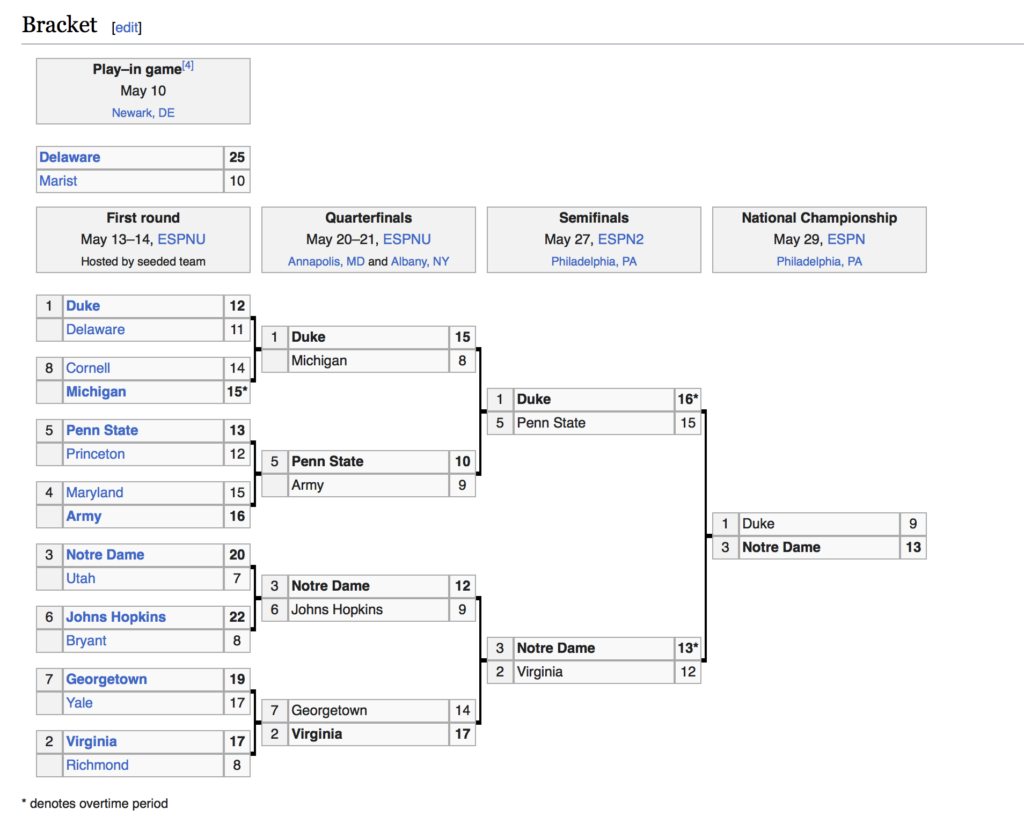
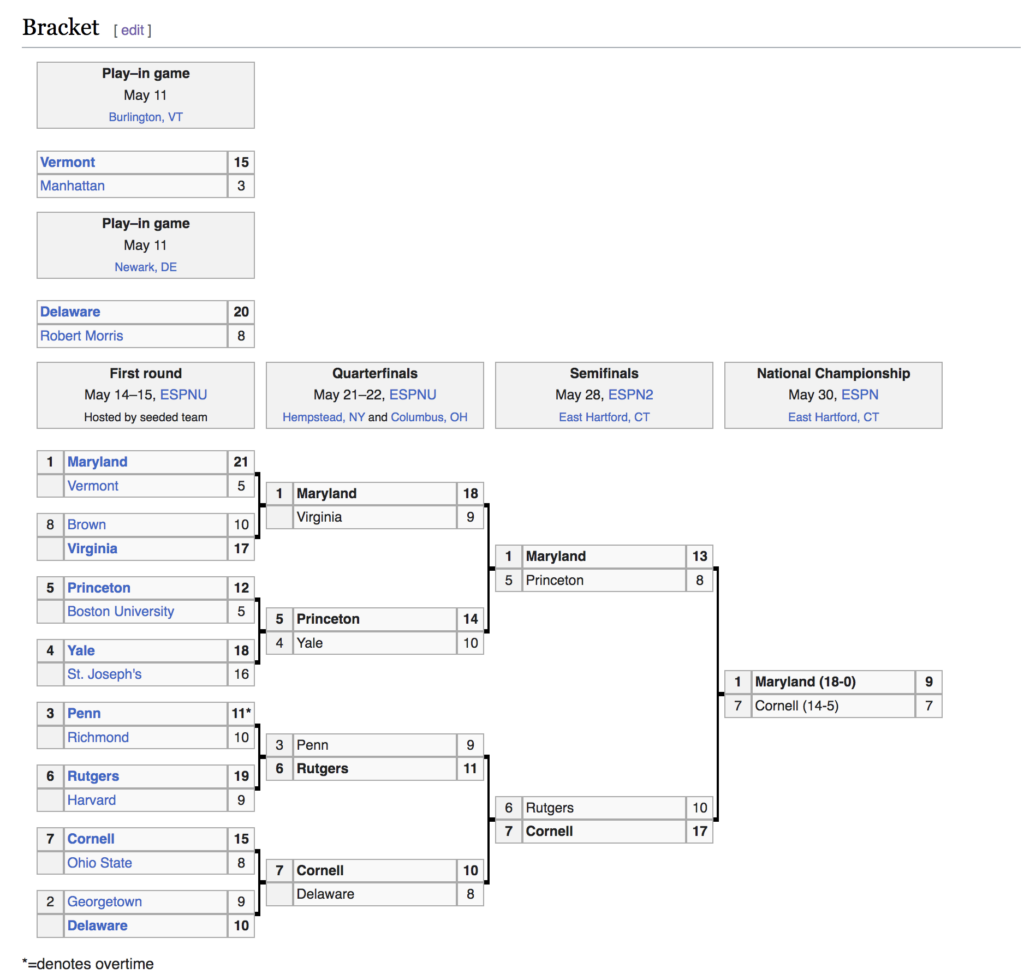
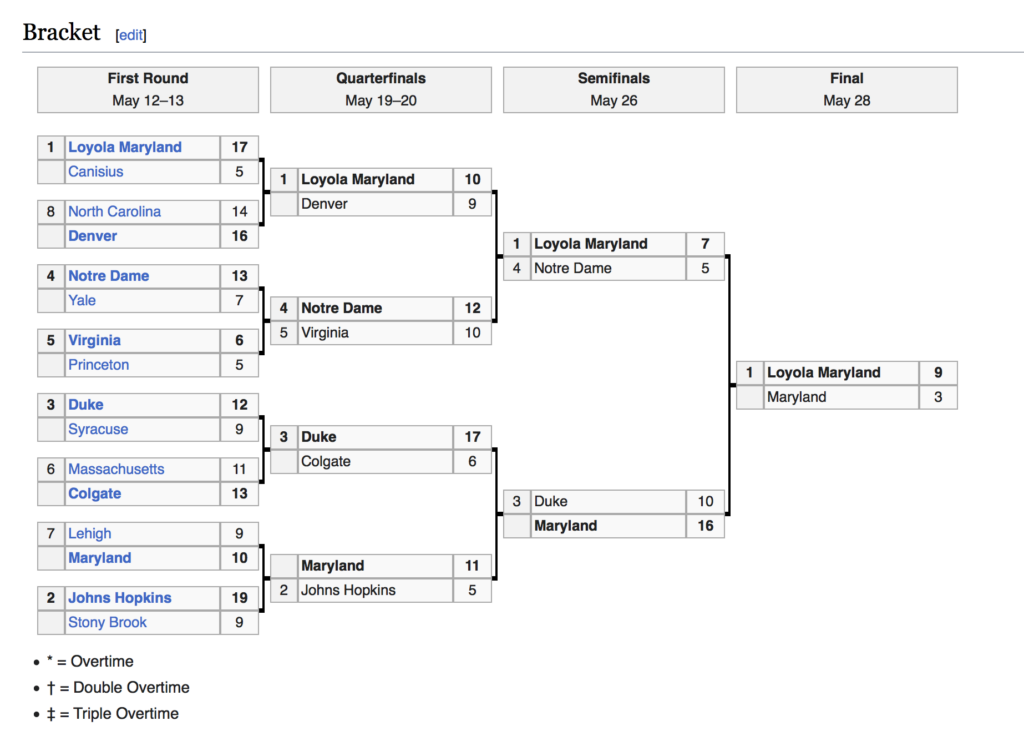
AQs: #1 Loyola (ECAC), #6 Massachusetts (CAA), #7 Lehigh (Patriot League), Yale (Ivy League), Syracuse (Big East), SUNY-Stony Brook (America East), and Canisius (MAAC). At-large selections: #2 Johns Hopkins, #3 Duke, #4 Notre Dame, #5 Virginia, #8 North Carolina, Denver, Maryland, Colgate, and Princeton. For the first round, there are 7 AQs and 9 at-larges.
The Future of the Tournament
I do not believe that we should expand the size of the lacrosse tournament field right now.
For the 2024 season, 9 conferences met the automatic qualifying criteria* set forth by the NCAA, yielding a 17-team tournament, with one play-in game. For the 2025 season, the Northeast Conference will once again sponsor men’s lacrosse, increasing the number of automatic qualifier conferences to 10. This number of automatic qualifiers yields an 18-team tournament, with two play-in games.
*Note: The ACC has 5 members, 1 short of the 6 required to receive an AQ bid.
DI men’s college lacrosse membership for the 2025 season:

Should the ACC add another school for lacrosse, or if a new conference forms, the NCAA’s Band-Aid-like play-in game solution will fail to serve its purpose. If there are 11 AQs, over half of automatic qualifiers — 6 of 11 — be sent to play-in games to comply with the above rules. With 3 play-in games, teams from outside the 3 primary power lacrosse conferences (ACC, Big Ten, Ivy League) competing for top 8 seeds might be sent to play-in games.
As recently as 2019, teams from the CAA (Towson) and Patriot League (Loyola), simultaneously earned seeds. We can easily imagine a situation where the ACC, Big Ten, Ivy League, Big East, Patriot League, and some other conference (A10/CAA) champions all get serious discussion for a seed, and in order to comply with NCAA bylaws, one of those teams must play a play-in game.
Additionally, using this season as a guide, either Towson or St. Joseph’s would almost certainly end up in a play-in game in this format. Each of these teams have had an excellent overall season, currently stand ranked in the top 15 of the media poll, and have won their conference championship.
At what point does the format of the bracket go from a representative championship tournament to a big brand invitational with a few lucky schools that can play their way in?
Is 11 AQ bids likely?
A future with 11 AQs is not imminent, but it may well occur within the next few decades. In theory, a sixth ACC school could make it a reality instantly. There may not be an existing ACC school that wants to add men’s lacrosse, but with many questions still unanswered about the future of the ACC, the conference reversing its position on single-sport affiliate membership could easily become a realistic possibility.
The more likely scenario, of course, is that the sport will eventually reach 11 AQ conferences at some point within the next decade or two through sustained and organic growth. Either way, now is the time to start thinking about what this future with 11 AQ conferences will look like!
The 24 team format
Once the sport has reached 11 AQ conferences, the NCAA tournament should expand to 24 teams: 11 AQs and 13 at-large bids.
Consider the 2024 season with the following changes: 1) the 2024 season was played with the 2025 conference alignments, so the Northeast Conference has already reformed as the 10th automatic qualifier conference, and 2) the Atlantic Coast Conference has added some 6th member, giving it an AQ. We’ll take the actual selection committee’s top 8 seeds as correct and conduct the selection process for the hypothetical 24 team tournament below:
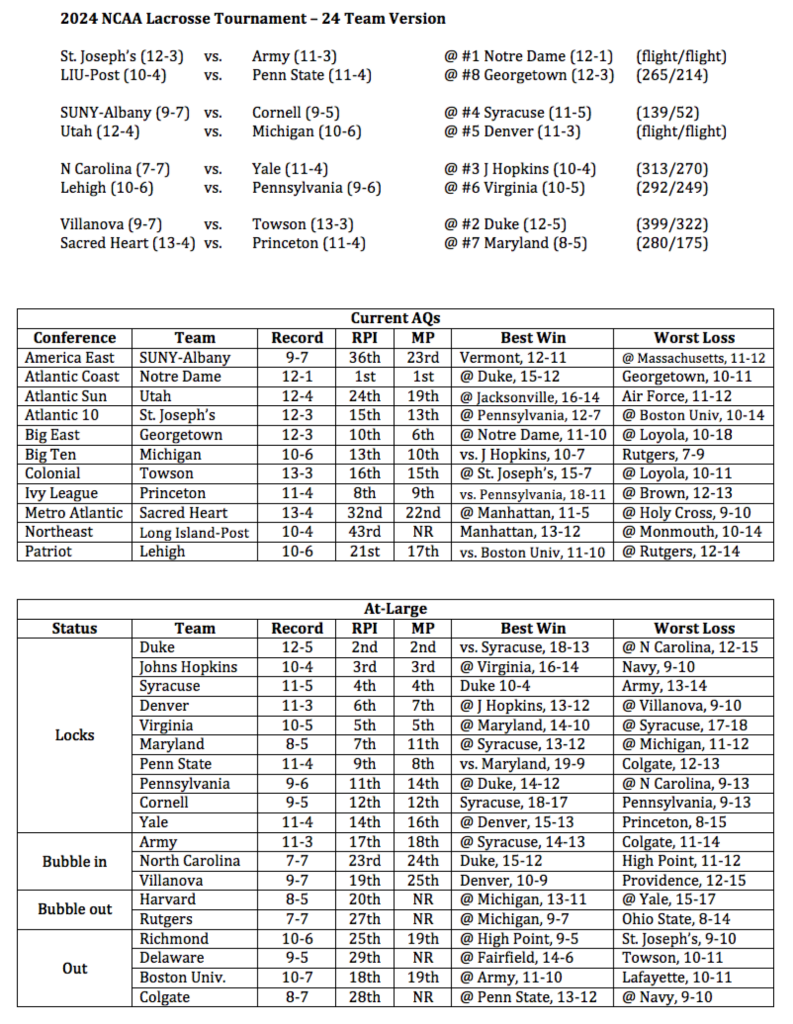

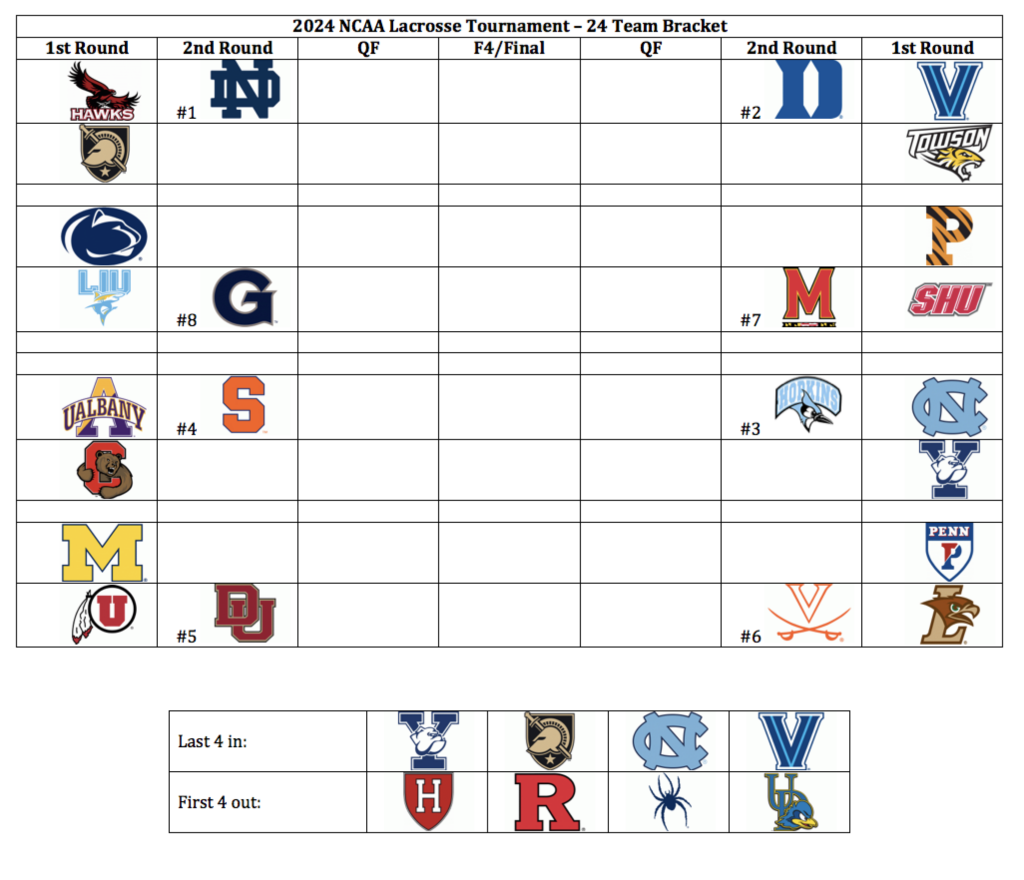

What is now the first round, the Round of 16, would become the second round, with identical times and television broadcast windows to how things currently are. The top 8 seeds would receive byes and still host these now second round games. The new first round would take place between teams 9-24 on Thursday and Friday at the site of the second round game into which they feed. For example, Army might play St. Joe’s in South Bend on Friday with the winner playing the Irish on Sunday.
The bracket on the right would resemble a 1-24 bracket as tightly as possible while:
1. Attempting to limit the number of first round flights required to 4 – doubled from the current goal of 2 flights – due to doubling the number of teams traveling for the first weekend of the tournament. This matters because the NCAA covers the cost of travel during the tournament, which is important to keeping the operating costs of a men’s lacrosse team low for smaller universities.
2. Avoiding placing two teams from the same conference at the same opening weekend (first and second rounds) site. If you examine my 1-24 seeding, compared to the 24 team bracket, no team has moved more than two positions from their “true” seed.
Teams 9-24 would then play either on Thursday/Saturday or Friday/Sunday, with games at the same site occurring in the same order across those days (e.g., the winner of the first game on Thursday would play in the first game on Saturday, and so on). Here is an example of what the opening weekend of this 24 team format might look like in terms of scheduling:
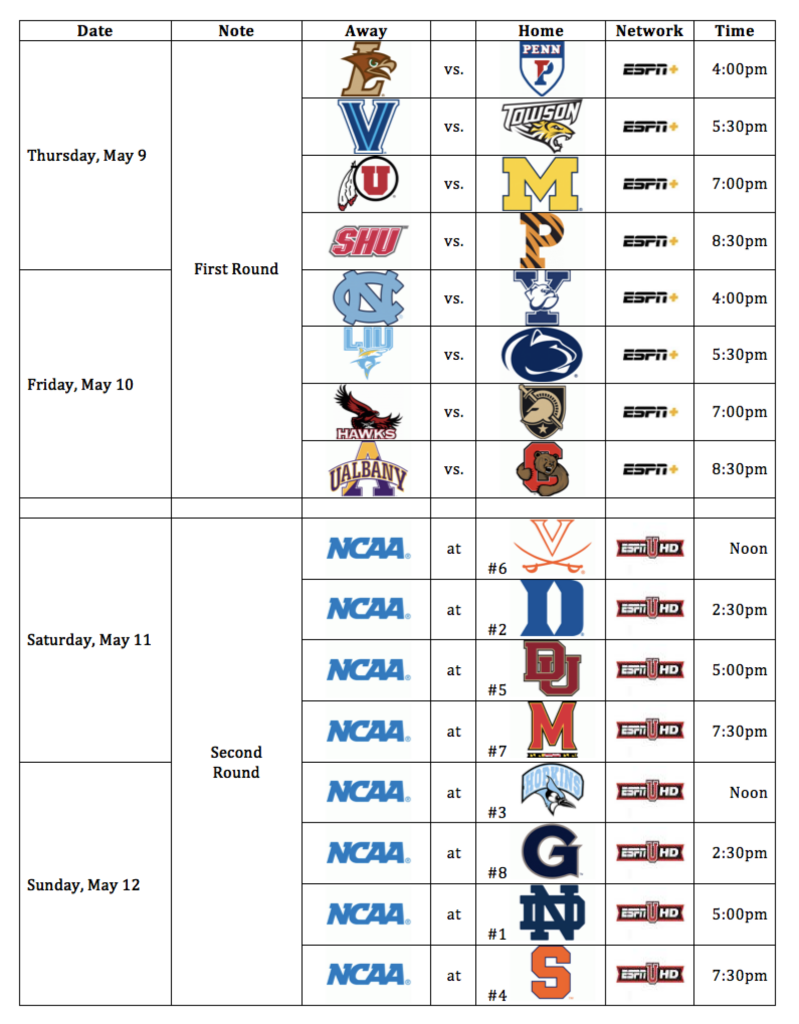
Why the Change?
We have one question to ask with any sort of playoff selection: What are we trying to reward?
With 11 AQs, a 19-team bracket would ultimately punish mid-major conference champions for having a good regular-season by placing them in play-in games, while rewarding bubble selections from power conference programs with direct placement into the first round. It is my opinion that the regular season should matter. Indeed, it should matter a lot.
It may seem like expanding the number of at-large selections would make the regular season matter less (e.g. the inclusion of North Carolina). That’s true to an extent, but the 24 team format guarantees that the top-8 regular season teams receive a bye; that is much more important than home-field advantage. Additionally, it guarantees that mid-major teams with great regular seasons that don’t win their conference’s AQ still have a legitimate path to selection – think 2019 High Point, 2022 Jacksonville, and 2024 Army.
The odds are not so insurmountable for teams 9-24 that the second round games aren’t worth playing, as we see all the time in conference tournaments. And when an unseeded team does reach the quarterfinals, at that point they’re back on nearly equal footing with the seeded teams.
Attitude Change
Under this proposal, there’s certain to be some adjustment from caring intensely about the bubble call to caring more about the 8/9 split line. This is nothing new. Before 1986, the tournament was only 8 teams with no AQs, so the 8/9 line became the bubble. Gradually, the tournament changed and expanded, so the cut line that people care about has also changed. In this new format, securing a top 8 seed and a bye is extremely important for title odds, and the debate around the first team out – a team that might look like 2024 Harvard – is sure to be less contentious than in recent years. Consider, for example, the debate surrounding the exclusion of Notre Dame in 2022.
This proposal also has the advantage of being able to add yet another AQ to its selection process without having to fundamentally change for a 12-12 AQ/at-large split. This protects the 24-team format against what will likely be many decades-worth of growth within the sport.
Outlook
The lacrosse community is still fairly small and there is a non-zero chance that some of the Division I Lacrosse stakeholders will read this. It is my sincere hope that someone out there likes this proposal enough that it ends up in the hands of decision-makers. I want our future as a sport to be a strong one, a future where decision-makers have considered the championship format and its incentive structure well in advance of the eventual emergence of an 11th AQ conference.











